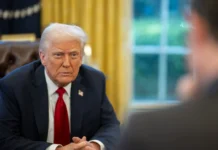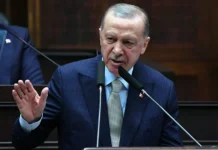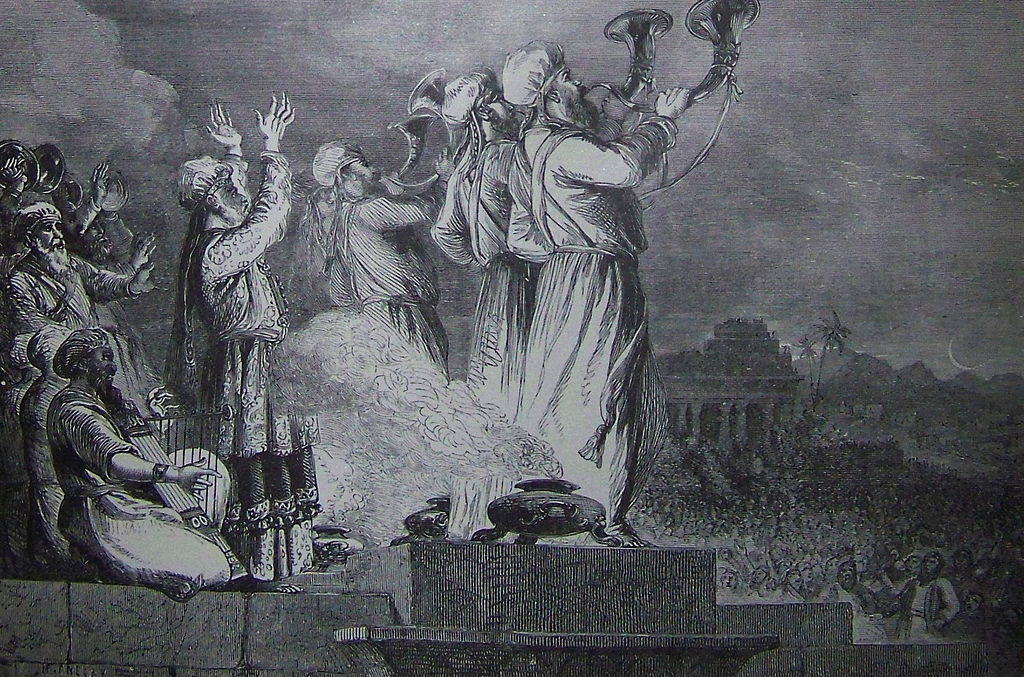HaShem, with His Divine attribute of mercy, commands Moshe to have Aharon “elevate” the Menorah lights (not light them), just as He elevated Aharon amongst Beni-Israel. While Moshe was “delayed” coming back from Mount Sinai, Aharon took upon himself the sin of the Golden-Calf by making it, the Torah writes that he just casted (threw) the gold into the fire and the Golden-Calf was created. From this miracle we know that HaShem had His “Hand” in such a creation and now we notice the same miracle in creation of the Menorah (“מנורה”) happened to Moshe. Moshe did not really understood how to construct the Menorah, HaShem performed the same miracle as he did for Aharon. The gold casted into the fire and the Menorah was created as a one piece “הַמְּנֹרָה מִקְשָׁה זָהָב”. We notice (in verse 2) that the word “HaNerot הַנֵּרֹת” (candles) appears twice, the first missing the letter “vov – וֹ” and in the second time in the same verse “הַנֵּרוֹת Hanerot” spelled with “vov – וֹ”. This teaches us about the divine creation of man in Beresheet, the word “HaNerot הַנֵּרֹת” is an acronym of four partners in creation:
- The letter “Hei – הַ” is HaShem
- The letter “Nun – נֵּ” is Neshamah
- The letter “Reish – רֹ” is Ruach
- The letter “Tav – ת” is Torah
The Torah did not write for Aharon to light the Menorah, but to elevate its candles. This higher form of lighting, comes to teach us that HaShem wanted us to light fire for him (every Hanukah), and Shabbat. Just as He lights fire for us in the Mishkan and Beit-HaMikdash for over 870 years combined. HaShem likes our lighting and elevating of his lights as He elevated us among the nations. Aharon was disappointed since all the heads of tribes brought gifts for the Mishkan, but he wasn’t asked to. HaShem said to Aharon, you will receive a much higher and important gift as it will last for eternity. By having Aharon light the Menorah daily, HaShem bestowed on his tribe a constant blessings and elevated him/his tribe to higher levels of Kedusha (holiness). The Midrash teaches us that Aharon did not have to light the candles daily as it was the other Kohanim’s responsibility, but he did so anyway with permission from HaShem. Aharon lit the Menorah for the next 39 years, until the day he passes in the year 2488 (on the first day of Av) since creation. HaShem also merited Aharon with an on-going gift known as “Birkat HaKohanim” (“ברכת הכוהנים”) the priestly blessing.
When HaShem taught Moshe about the Menorah, Moshe had difficulty understanding such a Divine vessel and how to construct it. HaShem instructs Moshe to build the Menorah from one piece of pure gold, HaShem showed him a “movie” as its written “כַּמַּרְאֶה, אֲשֶׁר הֶרְאָה יְהוָה אֶת-מֹשֶׁה”, hanse “You-Tube” already existed as the “cloud” (as we store images and data) “Clouds of Glory”. The word the Torah uses in Parashat Teruma is “Miksha” (“מקשה“), which in Hebrew comes from the word “Kashe” (“קשה” – difficult), as well as one piece. Notice that in the entire process of constructing of the Menorah, the letter “Samech” (“ס“) which alludes to the “Satan” (“סטן”) does not appear in any of the words. This teaches us that no such interference was ever allowed to enter this holy process. The Midrash tells us that Moshe could not construct the Menorah, so HaShem asked him to just throw the gold into the holy fire and miraculously the Menorah was created. The word “Miksah” in Hebrew, if rearranged also means “Meshika” (“משיקה” -providing drinking) speaking of the Torah as providing us with water, like “Mashke” (“משקה” – a drink) to satisfy our thirst.
The word “Mikshah” (“מיקשה “) (difficulty) has a hidden code in it, as its acronym represents the creation of four holy items and teachings that Moshe had difficulties understanding and couldn’t fully grasp without seeing an image:
- Mem – מ – for Menorah (how to build such creation)
- Kuf – ק – for Korbanot (how to perform sacrifices and how they serve such a Divine purpose)
- Shin – ש – for Shekel (half-shekel)
- Hei – ה – for HaChodesh (how to recognize the new moon and the blessings for Rosh Chodesh), setting up the Jewish calendar.
Only in the Mishkan and Beit-HaMikdash the Menorah had seven equal lights, however today we only see six or eight lights (plus the Shamash). The Kabbala teaches that the Menorah seven lights represented the human face. We have the 3 pairs as the two eyes, two ears, two nostrils, and the mouth as the Shamash the 7th. The seventh part the mouth, is most important part who can influence all the other parts. Interestingly enough there are nine planets in our solar-system just as our current Menorah has nine candles, with the earth as the Shamash. The seven lights of the Menorah also represented the seven earthly “Sefirot” a channel of Divine energy and life-forces. All together there are ten Sefirot, three upper and seven lower. The seven lights correspond to the seven “Sefirot,” the seven character traits with which we serve HaShem: kindness, strength, beauty, triumph, splendor, foundation, and kingship.
We notice that the Menorah had to be made from one piece of gold with its seven lights casting their illumination towards the center of the Menorah. Such Divine creation of one solid piece came to teach us that such vessel will be eternal binding, as we are to HaShem and the Torah. Just as the six week days and the Shabbat, provide the same Menorah’s unity to us and HaShem. We learn that HaShem instructed the Angels to help with constructing of the Menorah as its gold was cast into fire, and the Menorah appeared. HaShem wanted the Angels to be part of this great eternal Mitzvah with Bnei-Yisrael. It seems to be a minimal effort by Hashem to create the Menorah, to teach us the greatness of HaShem. Having the Menorah “construct itself” HaShem is showing that He can perform miracles fast and with minimal efforts for Bnei-Yisrael. The Menorah had to be made out of Gold only. Why? The word Gold (“זהב”) in this construction was given only by Bnei-Yisrael and not the Erev-Rav, the converts, as they gave the gold for the Golden-Calf.
A “measure for measure” used for the gold by Bnei-Yisrael. Due to use of gold for the Golden-Calf, HaShem gave them the opportunity to use gold for better use, for Torah. The word gold in Hebrew is “זהב” “Zahav” and it’s alluding to the use (reading) of Torah on these days in gematria:
Zien – “ז” – is 7 for Shabbat
Hei – “ה” – is 5 for Thursday
Vait – “ב” – is 2 for Monday.
These days always have Torah readings, to atone for the “זהב” “Zahav” used for the Golden-Calf.
We see that the word “and this” (“Ve-Zeh”) in verse four alludes to “this is the way of making the Menorah” (“וְזֶה מַעֲשֵׂה הַמְּנֹרָה מִקְשָׁה זָהָב”). The word “Zeh” (this) has the numerical value of 12 which alludes to the 12 tribes of Bnei-Yisrael, as they too will be binding for eternity with each other, as the Menorah and the Torah.
We must always remember that gold can be dangerous and could be used for a sin, just as it was used for the Golden-Calf episode. The word gold has another meaning when rearranging the letters; it will be “Biza” (“בזה”), shame and disgrace. This form of disgrace meant to teach us that when we do not use the gold (the Torah) for its intended purposes of holiness (as opposed to the golden-calf sin) we will bring disgrace upon us and be in exile. The Torah is compared to gold as it will always be as a fortune to us. Interesting to pint out that the best gold is 24 carat, the 24 alludes to the 24 books in our Torah (the Tanach). The Torah 613 Mitzvot drawn from the tablets of stone (hanse the use of “tablet” by apple…) are designated to eventually be placed within the Aron Kodesh (the Holy Ark). We read in Tehillim 19:11, “The words of Torah, are more desirable than gold, than even much fine gold; and sweeter than honey, and drippings from the combs” (“הַנֶּחֱמָדִים מִזָּהָב, וּמִפַּז רָב, וּמְתוּקִים מִדְּבַשׁ, וְנֹפֶת צוּפִים”).
Today we have the Torah but the gold of Beit-HaMikdash is gone, and as we know the destruction of both Beit-HaMikdash occurred on Tisha Be’Av. Nevuchadnetzer entered the first Temple on the seventh of Av, and it took his army two days to empty all the gold from the Beit-HaMikdash. Only then he destroyed the Beit-HaMikdash as HaShem ordered him to do, due to our sins. So too happened when the Titus the Roman destroyed the second Beit-HaMikdash, and he too took all the gold, as well as the Menorah. Today the Menorah and many other holy vassals are hidden in the Vatican (Rome) underground in the seventh floor below.
HaShem instructed Aharon to elevate the lights “in front” of the Menorah as it is written “אֶל-מוּל פְּנֵי הַמְּנוֹרָה”, Why? The lights are usually placed within the Menorah, and this act of elevation teaches us that the Menorah is part of HaShem’s Divine vessels just as the Altar and other divine vassals as they are “above nature”. Aharon was to perform his holy duties with precision just as HaShem commanded, above nature. Aharon did not deviate from HaShem’s commandment and by elevating the lights in front of the Menorah, he elevated HaShem’s name and the Menorah too. Our Sages say that there were three gold steps from the base of the Menorah, and Aharon had to humbly go up in order to light it. According to the Midrash, King Solomon hid this Menorah (along with four other holy vessels) after the distraction of the first Beit-HaMikdash, due to a prophecy of the destruction of the second Beit-HaMikdash.
In the book of Mishley (Proverbs 13) King Solomon wrote “Orr Tzadikim Yesmach Vener Rashaim Yedach” (“אור-צדיקים ישמח; ונר רשעים ידעך”), Meaning “The righteous men light will always rejoice and the wicked men candle will be put out”. Came to teach us that the sinners light is made out of wax and not oil and will always be extinguished, just as their soul. The righteous men will always be lit, just as their Neshamah will always rejoice and be resurrected in the future. When a candle is done its wick gets black and diminished, just as the wicked soul will end in total darkness in hell, while the Neshamah of a Tzadik will be illuminated and will end in total light in Heaven. Just as we light one candle to light other candles, the righteous man will illuminate others and help light up their lives without loosing any of their light. We see that HaShem’s Divine light needs no power source (Light travels at a constant, finite speed of 186,000 mi/sec) and forever lights up our world and our lives, so too the eternal light will illuminate our Neshamah. We know that the Menorah represents the Divine light for generations, as we light the candles on Shabbat, Hanukah, and Yom Tov. In Tehillim 97, HaShem promises such continuation and King David wrote: “The light will be forever planted for the righteous, as they will be rejoicing with HaShem for his holy sake.”
.”אור, זרוע לצדיק; ולישרי-לב שמחה. שמחו צדיקים, ביהוה; והודו, לזכר קודשו”
This comes to teach us that regardless of the existence of Beit-HaMikdash (or the lack of), HaShem keeps His “light” shine on for us, and He is with us throughout the exile (darkness).


























